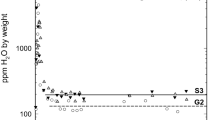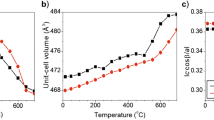Abstract
Optical spectroscopy indicated that the partial oxidation of Fe2+ to Fe3+ on heating natural cordierites above ∼500° C was not sensitive to oxygen partial pressure. This result suggested that the partial oxidation takes place by loss of mobile charge compensators such as protons. Ionizing radiation also produced partial oxidation of the minor-site Fe2+ to Fe3+, but this effect could be reversed by annealing at ∼300° C and so was due only to an electronic redistribution. Mössbauer spectroscopy confirmed these results, although there were complications due to apparent thermal decomposition in localized regions of the cordierites on heating in air.
Ionizing radiation also produced strong absorption in the near-ultraviolet and blue regions of the optical spectrum. This absorption, which was strongest in the α polarization, had different annealing characteristics to those of the crystal-field absorption bands near 10,000 cm−1. Dehydration by heating above ∼900° C severely reduced the subsequent effect of ionizing radiation on the optical spectra.
On heating over a temperature range spanning the dehydration temperature, the lack of any changes in the absorption energies of the β- and γ-polarized crystal field bands near 10,000 cm−1, of any changes in the ratio of the intensities of these β- and γ-polarized crystal field bands, and of any singularity in the intensity variations of the bands with heating temperature, all suggest that these bands originate from substitutional Fe2+ rather than Fe2+ in channel sites. Mössbauer evidence also supports this.
The formation of pleochroic haloes in cordierite is discussed briefly. No evidence of CO 3- centres in the irradiated samples was found.
Similar content being viewed by others
References
Brandt R (1978) Search for superheavy elements in nature and in heavyion reactions. In: Superheavy Elements (ed Lodhi MAK) Pergamon, London, pp 103–117
Butler CT, Sturm BJ, Quincy RB (1971) Arc-fusion growth and characterization of high-purity MgO crystals. J Cryst Growth 8:197–204
Cohen JP, Ross FK, Gibbs GV (1977) An x-ray and neutron diffraction study of hydrous low cordierite. Am Mineral 62:67–78
Deer WA, Howie RA, Zussman J (1966) An introduction to the rock-forming minerals. Longman, London, pp 84–89
Duncan JF, Johnston JH (1974) Single-crystal 57Fe Mössbauer studies of the site positions in cordierite. Aust J Chem 27:249–258
Edgar A, Vance ER (1977) Electron paramagnetic resonance, optical absorption and magnetic circular dichroism studies of the CO 3− molecular ion in irradiated natural beryl. Phys Chem Minerals 1:165–178
Gentry RV (1970) Giant radioactive haloes: indicators of unknown radioactivity? Science 169:670–673
Gentry RV (1973) Radioactive haloes. Ann Rev Nucl Sci 23:347–362
Gentry RV (1978) Are any unusual radiohaloes evidence for SHE? In: Superheavy Elements (ed Lodhi MAK) Pergamon, London, pp 123–154
Gibbons RV, Ahrens TJ, Rossman GR (1975) Spectra of shock-affected rhodonite: a reply. Am Mineral 60:942–943
Goldman DS, Rossman GR, Dollase WA (1977) Channel constituents in cordierite. Am Mineral 62:1144–1157
Goldman DS, Rossman GR, Parkin KM (1978) Channel constituents in beryl. Phys Chem Minerals 3:225–235
Harris EF, Crawford JH (1976) The influence of OH− impurity on the oxidation of iron impurity in MgO above 1,000° C. Phys Stat Solidi A35:667–673
Hashemi-Nezhad SR, Fremlin JH, Durrani SA (1979) Polonium haloes in biotite mica. Nature 278:333–335
Hochella MF, Brown GE, Ross FK, Gibbs GV (1979) High-temperature crystal chemistry of hydrous Mg- and Fe-cordierites. Am Mineral 64:337–351
Hsu FH, Vance ER (1980) Positron annihilation lifetime spectral changes on dehydration of natural beryls and cordierites. Phys Chem Minerals 6:47–53
Ivanitskiy VP, Matayash IV, Rakovich FI (1975) Effects of irradiation on the Mössbauer spectra of biotites. Geochem International 12:151–157
Kleim W, Lehmann G (1979) A reassignment of the optical absorption bands in biotites. Phys Chem Minerals 4:65–75
Molzahn D, Brandt R, Heinbold R, Jungelas H, Vater P (1980) On the evidence of “giant” haloes in cordierite. Nuclear Tracks 4:3–8
Nassau K, Prescott BE, Wood DL (1976) The deep blue Maxixe-type colour centre in beryl. Am Mineral 61:100–107
Poole JHJ (1928) The action of heat on pleochroic haloes. Phil Mag 5:132–141
Price DC, Vance ER, Smith G, Edgar A, Dickson BL (1976) Mössbauer effect studies of beryl. J Phys (Paris) Colloque 37:C6-811–817
Price DC (1981) Empirical lineshape for computer fitting of spectral data. Aust J Phys 34:51–56
Samoilovich MI, Novozhilov AI (1970) EPR spectrum of CH3, H2O+ and OH radicals and stomic hydrogen in beryl. Zh Neorg Khim 15:84–86
Selkregg KR, Bloss FD (1980) Cordierites: compositional controls of δ, cell parameters and optical properties. Am Mineral 65:522–533
Smith G, Strens RGJ (1976) Intervalence-transfer absorption in some silicate, oxide and phosphate minerals. In: The Physics and Chemistry of Minerals and Rocks (ed Strens RGJ) Wiley, New York, pp 583–612
Vance ER (1978) A possible mechanism for the formation of bleached, giant haloes in Madagascar mica. In: Superheavy Elements (ed Lodhi MAK) Pergamon, London, pp 228–235
Vance ER, Roy R, Pepin JG, Agrawal DK (1982) Chemical mitigation of the transmutation problem in crystalline nuclear waste radiophases. J Mater Sci 17:947–952
Violet CE, Pipkorn DN (1971) Mössbauer line positions and hyperfine interactions in α-iron. J Appl Phys 42:4339–4342
Window B, Dickson BL, Routcliffe P, Srivastava KKP (1974) A versatile multiple Mössbauer spectrometer. J Phys E: Sci Instrum 7:916–921
Wood DL, Nassau K (1967) Infrared spectra of foreign molecules in beryl. J Chem Phys 47:2220–2228
Author information
Authors and Affiliations
Rights and permissions
About this article
Cite this article
Vance, E.R., Price, D.C. Heating and radiation effects on optical and mössbauer spectra of Fe-bearing cordierites. Phys Chem Minerals 10, 200–208 (1984). https://doi.org/10.1007/BF00309312
Received:
Issue Date:
DOI: https://doi.org/10.1007/BF00309312




